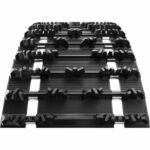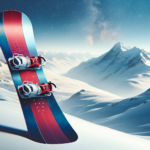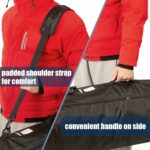Choosing the correct snowboard size can get a bit tricky, but don’t worry, this article got your back. In a nutshell, this article focuses on helping you understand the factors that determine the right snowboard size for you. It ranges from your body weight to your riding style and everything in between. Whether you’re an adrenaline junkie carving tracks on snowy peaks, or a beginner venturing into the exciting world of snowboarding – getting the perfect gear matters. So, let’s straightway get to the main question – “What is the right snowboard size for me?” and explore the answer together.
Understanding the Importance of Choosing the Right Snowboard Size
Venturing into the exciting world of snowboarding? Awesome! But before you jump headlong into the thrill, one crucial aspect to consider is the size of your snowboard. It’s not just about what looks cool or seems comfortable, the size of your board can significantly impact your snowboarding experience.
Why Size Matters in Snowboarding
It is absolutely vital to select the appropriate snowboard size because it influences your stability and control on the slopes. A snowboard that’s too short may make you feel unstable and cause you to lose balance easily, while one that’s too long might be difficult to maneuver. In other words, your ability to carve, jump, or do tricks depends largely on the size of your board.
Implications of an Inappropriate Snowboard Size
Choosing a snowboard that doesn’t quite fit your specifications can make your ride uncomfortable and unpredictable. For a beginner, an improperly sized board could make those initial learning stages much harder, potentially putting you off from the sport altogether. For an experienced boarder, the wrong board size can limit your ability to advance your skills and can even increase the risk of injury.
Factors Influencing the Choice of Snowboard Size
Several factors come into play when selecting the optimal snowboard size. These include your weight, height, shoe size, snowboarding style, experience level, and the terrain you’ll be riding on.
Rider’s Weight
Your weight is one of the key elements when determining snowboard size. The board should be able to support your weight while responding adequately to your movements.
Rider’s Height
Your height is also a crucial factor. Although there’s no strict rule that binds your height to a particular board length, it does influence the board’s responsiveness and maneuverability.
Rider’s Shoe Size
While often overlooked, your shoe size matters when it comes to choosing the right snowboard width. The goal is to avoid having boots that overhang excessively as this can result in unwanted contact with the snow during turns.
Snowboarding Style
Whether you love freestyling, free-riding, all-mountain boarding or splitboarding, each style demands a distinctive snowboard size to help optimize your performance.
Snowboarding Experience Level
Your proficiency in snowboarding can also determine the ideal snowboard size for you. The board’s size and design can either hinder or aid in enhancing your snowboarding skills.
Terrain Preference
Different terrains call for different snowboard sizes. A long snowboard is ideal for deep snow and big mountain terrains, while a shorter board is suitable for park or pipe terrains.
How to Measure Your Snowboard Size
To get the most out of your snowboarding experience, it’s essential to know how to measure your snowboard size accurately.
Using Snowboard Size Charts
Snowboard size charts offer a beneficial reference point. They usually provide a range of recommended snowboard sizes relative to your weight. However, remember that these charts are simply guides, other factors like your height, shoe size, snowboarding style, experience level, and terrain preference should also be considered.
Measurement Technique for Snowboard Length
Traditionally, the appropriate snowboard length was considered to be up to the rider’s chin. However, this technique is now deemed too simplistic as it doesn’t account for other factors like weight or snowboarding style. It’s better to refer to snowboard size charts and consider your skill-level and preferred terrain.
Measurement Technique for Snowboard Width
Your snowboard width correlates closely with your shoe size. A good indicator is to stand on your board (with snowboard boots); your toes and heels should be slightly over the edge of the board, but not too much to cause contact with the snow during rides.
Importance of Rider Weight in Snowboard Size Selection
Your weight holds substantial importance when it comes to selecting the right snowboard size.
How Weight Affects Board Control
A board that’s too short for your weight might buckle under pressure and struggle with high-speed stability. Conversely, a board that’s too long might feel stiff and make quick turns challenging.
Snowboard Size Recommendations Based on Weight
Most snowboard manufacturers rate their boards for specific weight ranges. If you’re a lighter rider, go for a shorter board, while heavier riders should opt for a longer board to ensure proper control and stability.
How Rider Height Influences Snowboard Size
The relation of your height to the snowboard size aids in maintaining balance and control during your ride.
How Height Affects Board Control
Taller riders generally need longer boards since they have a larger range of movement. Shorter riders, on the other hand, would usually benefit from a shorter board for better maneuverability.
Snowboard Size Recommendations Based on Height
While there’s no set in stone rule associating height with board length, a good guideline is that a board should reach somewhere between your nose and chin when stood up next to you.
Your Shoe Size and Snowboard Width
It’s crucial not to overlook the impact of your shoe size when choosing your snowboard.
Why Shoe Size Matters
Your shoe size can determine how much your feet overhang off the snowboard. Too much overhang can cause your toes or heels to drag in the snow and may affect your control over the board during turns.
Sizing Your Snowboard Width Correctly
For those with larger shoe sizes (usually US men’s 11 or above), consider getting a wider board to minimize overhang. Conversely, riders with smaller shoe sizes can go for regular width snowboards.
Snowboard Size Recommendations Based on Shoe Size
In general, if you wear a US men’s size 11 or larger shoe, you may want to consider a wide or extra wide board. For those with smaller shoe sizes, a regular width should suffice.
Snowboarding Styles and Snowboard Size
Different snowboarding styles require different board types and sizes. The needs of a freestyler differ greatly from those of a free-rider.
Different Snowboarding Styles and Their Requirements
Freestyle riders often prefer a shorter board for better control and maneuverability during tricks. Free-riders on the other hand might opt for longer boards to navigate steep and deep terrain. All-mountain riders usually go for a mid-length board, offering an excellent blend of control and versatility.
How Your Snowboarding Style Determines Your Snowboard Size
Your chosen style of snowboarding plays a critical role in determining the size of the board you require. For instance, if you’re into freestyle, a shorter board would be more manageable. If speed and steep slopes are your thing, a longer board would be more appropriate.
Terrain Preference Impact on Snowboard Size
The terrain on which you plan to snowboard influences your board size.
How Terrain Impacts Your Snowboard Choice
Steep, deep snow terrain demands a longer, more stable board. On the other hand, terrain parks and halfpipes usually call for a shorter, more maneuverable board.
Recommended Sizes for Different Terrain Types
For deep snow or Big Mountain snowboarding, a longer board (visible above your forehead when stood up next to you) is suitable. If the terrain park and pipe are more your scene, a shorter board (up to the chin) would be more practical.
Experience Level and Snowboard Size
Your experience and skill level also affect your ideal board size.
Snowboarding Requirements for Different Skill Levels
As a beginner, you might want a shorter board to learn control and maneuvers easily. Intermediate riders might benefit from a medium-length board that allows for more speed while still being maneuverable. Experienced riders often select a board length based on their specific riding preferences and style.
Snowboard Size Recommendations Based on Your Skill Level
If you’re new to the sport, a snowboard that stands vertically next to you and reaches up to your chin is a good starting point. As you gain skills and experience, you can opt for longer boards as per your ride style and personal preference.
Common Mistakes When Choosing a Snowboard Size
When it comes to choosing a snowboard size, there are a few pitfalls that you should try to avoid to ensure you get the ideal board for your needs.
Choosing a Snowboard Based on Design Only
Sure, the design of a snowboard can be tempting, but it shouldn’t overshadow the importance of the board’s size and suitability to your snowboarding needs. Functionality should always be your primary focus.
Not Considering Your Weight When Choosing a Size
Your weight has a significant impact on your snowboard’s performance, so ignoring this factor may hinder your snowboarding progress and enjoyment.
Not Considering Your Skill Level
As a beginner, going for a board that’s too advanced for your skill level can make learning much harder. Similarly, an experienced rider won’t enjoy a snowboard meant for beginners. Always take your skill level into account when choosing a board.
So there you have it! Now that you’re informed about how crucial the right snowboard size is, you’ll be better equipped to make the best choice for yourself. Remember, the ultimate aim is to maximize your snowboarding experience, and the right board size is a catalyst in achieving that goal. Happy snowboarding!
- What Snowboard Bindings Should I Get? - January 23, 2024
- What Size Screws For Snowboard Bindings? - January 23, 2024
- How To Snowmobile On Water? - January 23, 2024










